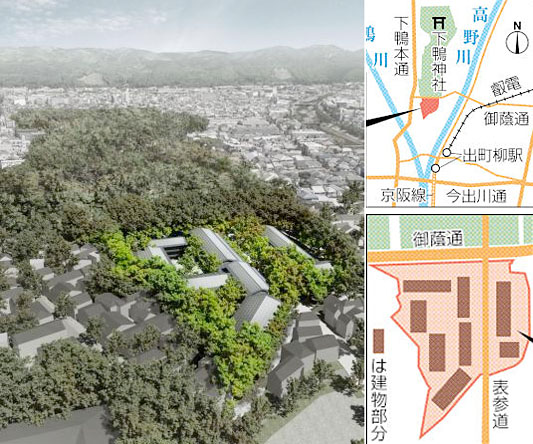Apartments to be built in historic Kyoto Shrine grounds

Shimogamo Shrine in Kyoto’s Sakyo Ward announced that several condominiums will be built on part of the shrine’s grounds.
The shrine’s main buildings are rebuilt every 21 years. To help raise the 3 billion Yen required to rebuild in 2015, part of the shrine’s land will be leased to a private developer. The shrine has already raised 1 billion Yen and will receive around 800 million Yen in national grants.
A 9,650 sqm parcel of land about 600 meters south of the main shrine will be leased to a private developer under a 50-year term with an annual land rent of 80 million Yen. At the end of the lease, the buildings will be demolished and the land will be returned to the Shrine. The land is currently used as a car park and training hall.Read more
600 billion Yen project announced for Yaesu

Mitsui Fudosan and Tokyo Tatemono have plans for a 600 billion Yen (5 billion USD) redevelopment on the eastern side of Tokyo Station. Two buildings up to 250 meters tall will be built in the Yaesu 1 and 2 Chome districts. The developers are considering including residential, retail, education, cultural and medical facilities with English-speaking staff in the complex. The Yaesu area currently has a resident population of just 110 people, so residential supply has been very limited.
The redevelopment site is located in a National Strategic Special Zone. These zones have been created to encourage the creation of full-service business districts that are internationally competitive. Developers may receive allowances to provide for extra floor-area ratios and foreign companies may receive additional benefits to locate in these areas.Read more
Residential yields in Minato-ku - March 2015

According to real estate listing site Homes, the average gross yield on an apartment in Minato-ku in March was 5.0%, down 0.2 points from the previous month and down 0.5 points from last year. The average gross yield across Tokyo was 6.6%, down 0.2 points from the previous month and down 0.7 points from last year.
The average asking price of a second-hand apartment in Minato-ku was 890,457 Yen/sqm as of March 1, up 0.7% from the previous month and up 14.2% from last year. The average asking price for land was 1,246,667 Yen/sqm, down 0.6% from the previous month but up 17.2% from last year.
Residents seek urgent reconstruction of faulty building in Fukuoka
 The residents of a condominium in Kurume City, Fukuoka, that was found to have a considerably low level of earthquake-resistance, have filed a lawsuit against Fukuoka City seeking reconstruction of the building within the next 12 months.
The residents of a condominium in Kurume City, Fukuoka, that was found to have a considerably low level of earthquake-resistance, have filed a lawsuit against Fukuoka City seeking reconstruction of the building within the next 12 months.
According to the lawsuit, the 15 storey condominium was constructed by a subcontracting company of Kajima Corporation in 1996. Issues began shortly after completion, with exterior tiles from upper floors coming loose and cracks appearing in the building’s hallways. Since 1997, residents have repeatedly requested that the developer and construction company investigate and repair the building.Read more
Japan’s largest hotel to be built in Yokohama

APA Group will be developing a 37-storey hotel on a waterfront site in downtown Yokohama. With 2,400 guest rooms and a total floor area of 58,000 sqm, this hotel will have the highest room count in a single building in Japan.Read more
Luxury apartment boom in Kyoto fuelled by Tokyo buyers
Kyoto is seeing a renewed interest from wealthy buyers looking for luxury holiday homes. A number of high-end condominiums in central Kyoto have been selling out quickly due to demand from Tokyo residents. The historic city, which is an admired and world-renowned tourist destination, is additionally appealing as its real estate prices are relatively cheap when compared to Tokyo. Supply is also limited due to to various height restrictions and a shortage in available development sites.
The area inside Oike, Gojo, Kawaramachi and Horikawa Streets has seen the recent development of several luxury apartments.

Nomura Real Estate’s ‘Proud Kyoto Fuyacho Oike’ is currently under construction alongside Oike Dori Avenue and 200 meters from Kyoto City Hall. Apartments went on sale in December 2014 and the 43 units received 83 purchase applications (lucky buyers were selected from a raffle). The two, three and four bedroom apartments ranged in size from 67 ~ 104 sqm (721 ~ 1,119 sq ft) and were priced from 60 ~ 140 million Yen. 80 sqm apartments were priced in the 80 million Yen (670,000 USD) range. Apartments are scheduled for delivery from the end of March 2016.Read more
Tokyo apartment sales in February 2015

The following is a selection of apartments that were sold in central Tokyo during the month of February 2015:Read more
